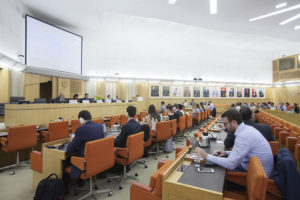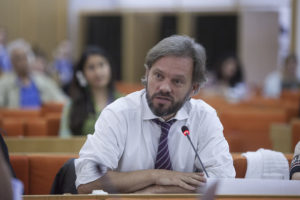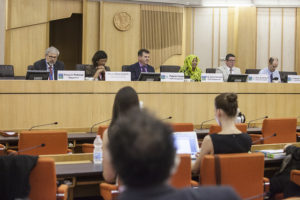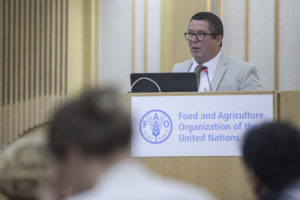FTA research and engagement inform biodiversity and climate change policies
Each year, reports on declining biodiversity and the accelerating impacts of global change become more alarming. But what is often not emphasized is how differently these global challenges affect women and men and how women and men can differently address them.
For example, studies suggest large-scale gender differences in mortality rates associated with natural disasters, particularly where women are socioeconomically disadvantaged and where disasters exacerbate existing patterns of discrimination. But in 2015, only 0.01% of worldwide grant dollars addressed both climate change and gender inequalities.
Gender-blind policies and actions risk increasing and exacerbating inequalities within households, decreasing women’s well-being and creating disincentives for women’s participation, as shown in an FTA study on perceptions of well-being in communities that have taken part in reducing emissions from deforestation and forest degradation (REDD+) projects.
There is also evidence that gender-equitable policies and projects can lead to better institutional and environmental performance. FTA research has helped contribute to more gender-responsive global policy processes, for example through gender research that influenced the design of policy documents used to inform the negotiation processes in the United Nations Convention on Biological Diversity (CBD).
“This is a critical juncture,” said Marlène Elias, FTA Gender Research Coordinator. “We have to seize this moment as CBD develops its new strategy (the Post-2020 Global Biodiversity Framework) for the coming decade.”
FTA scientists are collaborating with a network of organizations that have been pushing for more gender-responsive policies for years. Among this constellation of actors, the role of FTA scientists is to bring empirical evidence to the table.
Evolution of engagementIn 2018, based on their submission on gender mainstreaming to the Subsidiary Body for Implementation (SBI) of the UN Framework Convention on Climate Change (UNFCCC), the UNFCCC secretariat invited FTA scientists to present empirical evidence on the links between gender and climate change at an in-session workshop at the 48th session of the SBI. Concurrently, FTA scientists were invited to join the For All Coalition, which aims to inform gender integration under the United Nations Rio Conventions. FTA was thus one of few research initiatives represented in the coalition, which brings together parties to the Conventions, members of the Conventions’ secretariats, and key gender non-governmental organizations (NGOs) to inform gender integration and negotiations under the Conventions. Also in 2018, FTA and the United Nations Entity for Gender Equality and the Empowerment of Women (UN Women) jointly developed a paper on gender issues under the CBD that served as a background document to the CBD’s 14th Conference of the Parties (COP14). The paper was later submitted as a note by the executive secretary and considered as an agenda item at COP18. FTA also contributed to a workshop on 1 July 2018 that was co-led by UN Women and the CBD Secretariat, held on the sidelines of the 22nd meeting of the Convention’s Subsidiary Body on Scientific, Technical and Technological Advice (SBSTTA-22) and the second meeting of the Subsidiary Body on Implementation (SBI-2). Its aim was to strengthen the capacities of Convention delegates to integrate gender into intergovernmental deliberations and the implementation of the Convention, the Aichi Biodiversity Targets, and National Biodiversity Strategies and Action Plans (NBSAPs). A big win at CBD COP14 was the agreement among Parties to a gender-responsive process to develop the Post-2020 Global Biodiversity Framework, by systematically integrating gender considerations and ensuring that women and girls are adequately represented in the process. This gave way to renewed efforts among FTA and partners to influence the process, including through an expert workshop held in 2019 in New York, in which FTA participated along with representatives from national governments, civil society organizations and movements, UN agencies and other international organizations. The workshop was one in a series to build consensus around the key elements for a gender-responsive Post-2020 Global Biodiversity Framework. Iliana Monterroso, a scientist and co-coordinator of Gender and Social Inclusion Research at the Center for International Forestry Research (CIFOR, the FTA lead partner), presented FTA’s research-based recommendations, which were included in the forestry section of the workshop report. Drawing on lessons from gender-responsive forest landscape restoration work, these recommendations were to: recognize land rights, knowledge, and natural resources; build capacity among women through economic empowerment initiatives and green entrepreneurship opportunities and training; create gender parity quotas, including quotas for socially excluded groups; audit women’s contribution to the forest sector; and map existing and pending claims around resources. “During the presentation, we drew from previous research around REDD+ issues to highlight lessons learned and synergies in order to incorporate gender in the discussion of the upcoming strategy. We highlighted how some of these challenges are not unique to the implementation of restoration or biodiversity agendas but are partly the result of structural gender inequalities that need to be addressed in order to derive the expected outcomes,” said Monterroso. As the dynamic engagement with the CBD secretariat and expert group evolved, FTA contributed to joint submissions with other participating organizations to inform the Post-2020 Global Biodiversity Framework, including during the Regional Consultation of the Group of Latin America and the Caribbean in Montevideo. FTA and UN Women also co-hosted an expert workshop on the ICRAF campus in Nairobi to formulate key messages for the First Meeting of the Open-ended Working Group (OEWG) on the Post-2020 Global Biodiversity Framework. The meeting resulted in recommendations to the OEWG for gender-responsive goals, indicators and targets; an accountability framework; and enabling conditions, including capacity-building and finance, for the Post-2020 Global Biodiversity Framework, which is currently under revision. |
As a result of its strong reputation for gender research and active engagement with the Rio Conventions processes (see Box), FTA has been invited to contribute to several global initiatives to establish and track progress towards gender equality targets. For instance, in the drafting of the Equal Measures 2030 global report, FTA has provided recommendations on gender indicators for the Sustainable Development Goal (SDG) 13 on climate change. The report referenced FTA’s submission to the UNFCCC SBI and two FTA studies,[1] and underlined the importance of the inclusion of women in national decision making on climate policies. FTA’s submission was also widely cited in a recent synthesis report on gender and climate change developed by the UNFCCC secretariat. In 2019, FTA scientists also participated in designing and delivering a capacity-building workshop on gender mainstreaming with the UNFCCC Least Developed Countries Expert Group (LEG).
“One thing we have learned from our engagement in the UNFCCC processes is that there has been a disconnect between the growing body of research on gender and climate change, on one hand, and the really strong demand by Parties and other stakeholders for data to support evidence-based, gender-responsive climate policy and practice, on the other,” said Markus Ihalainen, a senior research officer and co-coordinator of Gender and Social Inclusion Research at CIFOR. “There are many topics that merit further investigation, but we know enough to say that lack of evidence cannot be an excuse for gender-blind climate policy making. FTA has done so much work on this topic, and when we can help it reach the right people and processes, we see that there is a whole lot of interest in taking it up.”
The power of language
One important way of influencing a more gender-responsive agenda is through advocating for more progressive language in policy texts. Since language frames content and approaches, having a common and meaningful language around gender across global policies, such as the Rio Conventions, would facilitate more harmonized and synergistic implementation and monitoring and lead to more positive, impactful changes towards gender equality.
FTA gender experts engage with a wide range of stakeholders to both support evidence-based, gender-responsive policy-making, as well as to provide guidance and tools for effective and equitable implementation and monitoring on the ground.
“We want to make sure that appropriate language – which has been developed through a range of consultations with gender specialists and gender equality advocates and across global policy processes, such as the UNFCCC and the SDGs – is retained and imported into every new effort,” said Elias. “For example, there is an agreed way to refer to the participation of women and marginalized groups as ‘full, effective and meaningful’. Such language has been hard fought for and vetted by gender equity groups.”
Weaving this iteratively developed language on gender throughout global policies that affect rural women – and ensuring that it guides implementation and action on the ground – is a worthwhile effort. To support this effort, FTA gender experts continue to bring the latest science to the discussions among global networks of gender-focused organizations.
[1] CIFOR-FTA (2013). E. Coleman and E. Mwangi, “Women’s Participation in Forest Management: A Cross-country
Analysis,” Global Environmental Change 23 (no. 1): 193-205, February, 2013.
This article was written by Erin O’Connell.
This article was produced by the CGIAR Research Program on Forests, Trees and Agroforestry (FTA). FTA is the world’s largest research for development program to enhance the role of forests, trees and agroforestry in sustainable development and food security and to address climate change. CIFOR leads FTA in partnership with ICRAF, the Alliance of Bioversity International and CIAT, CATIE, CIRAD, INBAR and TBI. FTA’s work is supported by the CGIAR Trust Fund.















